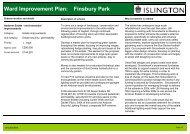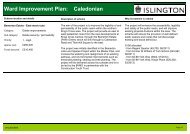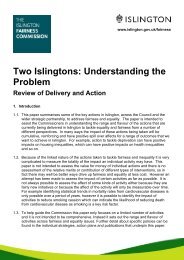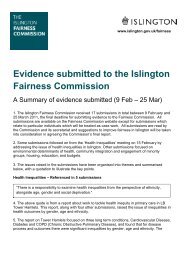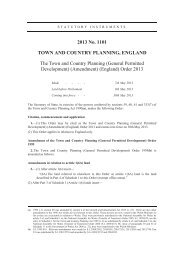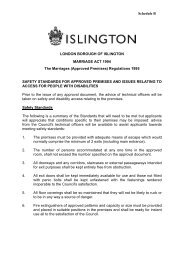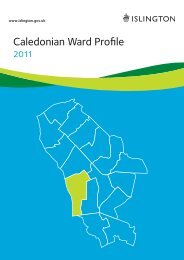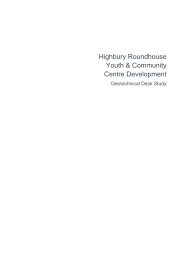Malicious Damage - Islington Council
Malicious Damage - Islington Council
Malicious Damage - Islington Council
You also want an ePaper? Increase the reach of your titles
YUMPU automatically turns print PDFs into web optimized ePapers that Google loves.
M<br />
The life and crimes of Joe Orton<br />
and Kenneth Halliwell in <strong>Islington</strong><br />
In 1962 aspiring writer Joe Orton<br />
and his partner and mentor Kenneth<br />
Halliwell were each sentenced<br />
to six months imprisonment for<br />
‘malicious damage’ to <strong>Islington</strong><br />
Public Library books.<br />
They were found guilty of theft and defacing library<br />
book covers by adding alternative images from<br />
other sources or inserting new text and narrative.<br />
In the process Orton and Halliwell produced<br />
‘guerrilla artwork’, motivated by what they believed<br />
to be the “endless shelves of rubbish” that they<br />
found in public libraries.<br />
The ‘collage’ work in <strong>Islington</strong> had begun after Orton<br />
and Halliwell moved to the area in 1959. The couple<br />
also removed illustrations from library art books to<br />
’wallpaper’ their bedsit flat at 25 Noel Road.<br />
Imprisonment proved difficult for Kenneth Halliwell<br />
and he tried to commit suicide while inside. Joe<br />
Orton’s incarceration, however, proved inspirational<br />
and he embarked upon what was to be a successful<br />
but all too brief writing career, cut short by his<br />
murder at the hand of his jealous partner in 1967.<br />
Library wallpaper: An example of ‘interior design’ discovered at Orton<br />
and Halliwell’s <strong>Islington</strong> flat after the police raid in April 1962.<br />
The now infamous doctored book covers form the<br />
‘Joe Orton Collection’ held at <strong>Islington</strong> Local History<br />
Centre. Fortunate to survive after the court case,<br />
these collage works are among the most viewed<br />
items at the Centre.<br />
‘<strong>Malicious</strong> <strong>Damage</strong>’ tells the story surrounding the<br />
life and crimes of Orton and Halliwell in <strong>Islington</strong>.<br />
Accompanied by the surviving doctored covers,<br />
the exhibition reflects upon the couple’s creative<br />
and mischievous talents while resident in this north<br />
London borough.<br />
Guerrilla art: An <strong>Islington</strong> library<br />
book cover ‘maliciously damaged’ by<br />
Orton and Halliwell, 1959-62.<br />
Life after prison: Joe Orton<br />
in <strong>Islington</strong>, 1964.<br />
A break from <strong>Islington</strong>:<br />
Kenneth Halliwell in<br />
Morocco, 1965.
Opening act:<br />
John Kingsley<br />
Orton<br />
John ‘Joe’ Kingsley Orton’s short,<br />
yet incandescent life began in<br />
Leicester on New Year’s Day, 1933.<br />
He was the eldest son of a council<br />
gardener and a machinist eager<br />
for him to escape a sedentary life.<br />
Joe’s vision of escape from the<br />
drudgery of working class, postwar<br />
Leicester was very different to<br />
his parents’ - he wanted to act.<br />
It was through amateur dramatics<br />
that he found a way out. Aged<br />
18, Orton was accepted for a<br />
scholarship at the prestigious<br />
Royal Academy of Dramatic Art<br />
(RADA) in London. It was here in<br />
May 1951 that the young drama<br />
student first met his long-term<br />
partner Kenneth Halliwell.<br />
Kenneth Leith<br />
Halliwell<br />
Born in Birkenhead on 23 June<br />
1926, Kenneth Halliwell had a<br />
troubled childhood. His mother,<br />
with whom he was very close,<br />
choked to death when he was<br />
11 years old and his father later<br />
committed suicide when Kenneth<br />
was aged 23.<br />
Halliwell’s upbringing was, however,<br />
aspirational compared to Orton’s.<br />
He was born into money, welleducated<br />
and destined to become<br />
a writer. Halliwell moved to London<br />
to study drama at RADA, having<br />
received a small family inheritance.<br />
A month after meeting at<br />
RADA, the two students were<br />
living together in Halliwell’s<br />
West Hampstead flat at 161<br />
West End Lane. This was to<br />
be the beginning of an intense<br />
relationship lasting 16 years.<br />
Master and pupil<br />
The learned Halliwell saw his new<br />
but inexperienced partner as his<br />
young apprentice. With Halliwell<br />
as mentor, Orton went through<br />
a metamorphosis, absorbing<br />
a wealth of art and culture<br />
previously denied him.<br />
Following graduation from RADA,<br />
the two newly-trained actors<br />
experienced a brief flirtation with<br />
regional repertory theatre but soon<br />
returned to London to devote their<br />
energies to becoming successful<br />
writers. It was during this time<br />
that the couple started writing<br />
together, supplemented by casual<br />
work. In 1959 Halliwell was to<br />
purchase a tiny flat in <strong>Islington</strong>.<br />
Amateur dramatics: Joe Orton<br />
(fourth from left) in the Vaughan Players’<br />
production of Agamemnon, 1950.<br />
RADA awaits:<br />
Joe Orton aged 16 years in 1949.<br />
Mentor: Kenneth Halliwell in 1967 –<br />
erstwhile master to Joe Orton’s pupil.
Act two:<br />
Noel Road<br />
From 1959 until 1967, the second floor bedsit flat<br />
measuring just 16ft x 12ft at 25 Noel Road was Orton’s<br />
and Halliwell’s residence and centre of operations. The<br />
bed-sitter afforded Orton and Halliwell security when<br />
writing together. When not at home, the two men spent<br />
much of their day using their local public library service but<br />
not for the usual reasons!<br />
Cover story<br />
Public libraries should have played a major role in Orton’s<br />
re-education but enraged by library bookshelves weighed<br />
down by what he and Halliwell considered to be “so<br />
many rubbishy novels and rubbishy books” and the lack<br />
of “good taste,” they embarked upon an unusual and<br />
creative form of protest.<br />
They began by systematically stealing library books<br />
from their local public libraries: Essex Road (now South)<br />
Library and the larger Central Library on Holloway Road.<br />
At home the pair ‘doctored’ the library book covers with<br />
alternative images from other sources to create collages,<br />
or by adding new text and narrative to the jackets’ blurb.<br />
In the process Orton and Halliwell were to create a form<br />
of ‘guerrilla artwork’. They also removed illustrations<br />
from library art books to ’wallpaper’ their flat.<br />
Joe and Ken’s former‘playhouse’: Central<br />
Library, Holloway Road, 2011.<br />
Doctored: A library book<br />
cover defaced by Orton<br />
and Halliwell, 1959-62.<br />
Library theatrics<br />
Home: 25 Noel Road,<br />
<strong>Islington</strong>, 2011.<br />
Anonymously returning the altered covers and their<br />
books to the libraries, Orton and Halliwell would often<br />
loiter behind library shelves to observe the reaction of<br />
readers when they selected a title with a defaced jacket.<br />
John Lahr, Orton’s biographer, commented that the<br />
pair “turned the library into a little theatre, where they<br />
watched people reacting to their productions.”<br />
Joe Orton later recalled:<br />
”I used to stand in the corners after I’d<br />
smuggled the doctored books back into<br />
the library and then watch people read<br />
them. It was very funny, very interesting.”<br />
A home from home: Essex Road<br />
(now South) Library, 2011.<br />
Cover notes:<br />
Dorothy L. Sayers’<br />
Clouds of witness jacket<br />
blurb ‘amended’ by Orton<br />
and Halliwell, 1959-62.
Act three:<br />
M<br />
Suspicion<br />
Orton and Halliwell’s work did not go unnoticed by<br />
library staff. The finger of suspicion started pointing<br />
at “…two men who shared the same address and who<br />
always visited the library together.” A cunning plan<br />
to bring about an end to their lengthy and nefarious<br />
campaign was devised early in 1962.<br />
Sidney Porrett<br />
<strong>Islington</strong> <strong>Council</strong>’s Principal Law Clerk, Sidney Porrett,<br />
masterminded the plan to ensnare the two prime<br />
suspects stealing and defacing <strong>Islington</strong>’s library books,<br />
namely Orton and Halliwell:<br />
Arrest<br />
The culmination of an 18-month investigation into the<br />
persistent theft and alteration of public library property<br />
came to an end on the morning of 28 April 1962 when<br />
two policemen knocked upon the couple’s door.<br />
Upon answering, and hearing the reason for the<br />
warrant, Halliwell simply said, “Oh dear.” Once inside the<br />
flat the police found walls covered from floor to ceiling<br />
in pictures removed from library books.<br />
Orton and Halliwell were duly arrested and the following<br />
month appeared before local magistrates. The judiciary<br />
were to denounce the pair’s acts as “sheer malice and<br />
destruction from which the public must be protected.”<br />
“I had to catch these two monkeys. I<br />
thought OK, I’ll let my ethics slip a little<br />
bit. I wanted to get them aggravated.<br />
They were a couple of darlings, make<br />
no mistake.”<br />
Porrett’s idea was to try and obtain a sample of print<br />
from the typewriter used to produce the false jacket<br />
blurbs. A bogus letter dated 15 February 1962 was<br />
sent to Halliwell at Flat 4, 25 Noel Road requesting that<br />
he remove an abandoned car supposedly owned by him<br />
-no such vehicle existed.<br />
Halliwell’s indignant response was his and Orton’s<br />
undoing. The police forensic lab confirmed that his<br />
typed reply and the false jacket blurbs were produced<br />
by the same machine and a search warrant was issued.<br />
Interior design: An example of ‘library wallpaper’ discovered<br />
at Orton and Halliwell’s <strong>Islington</strong> flat after the police raid<br />
in April 1962.<br />
Nemesis: Sidney Porrett,<br />
1982. <strong>Islington</strong> <strong>Council</strong>’s<br />
Principal Law Clerk and Orton<br />
and Halliwell’s adversary.<br />
Back home: Joe Orton relaxing at home<br />
in 1964, two years after his arrest,<br />
with collage-style wallpaper still<br />
the preferred decoration!
Act four:<br />
B<br />
e ca s e e w<br />
e<br />
uee<br />
Guilty<br />
On Tuesday 15 May 1962, John Kingsley Orton<br />
and Kenneth Leith Halliwell appeared at Old Street<br />
Magistrates’ Court. They were charged with stealing<br />
72 library books and damaging several others, which<br />
included the removal of 1,653 plates from art books,<br />
the property of <strong>Islington</strong> Borough <strong>Council</strong> and Library<br />
Service.<br />
Release<br />
Upon completing their sentences, the pair returned to<br />
Noel Road. The balance of power between them had<br />
shifted and Orton was now writing independently.<br />
Halliwell had turned, ironically, to a new art form -<br />
collage. He hoped that it would bring him fame but this<br />
proved not to be the case. For Joe Orton, however,<br />
success was soon to follow.<br />
Both pleaded guilty to a total of seven charges of<br />
theft and unlawful, malicious and wilful damage, and<br />
each sentenced to six-month imprisonment with<br />
fines. <strong>Damage</strong>s and costs of £262 17s 6d were<br />
subsequently awarded to <strong>Islington</strong> Borough <strong>Council</strong> in<br />
the civil court. Joe was to comment, “I know what I did<br />
was wrong but I’m just unrepentant.” And, when later<br />
asked why he thought they had been given such harsh<br />
sentences, Orton replied, “Because we were queers.”<br />
Homosexuality was never mentioned during the trial.<br />
Prison life<br />
The pair went first to HM Prison Wormwood Scrubs in<br />
London, after which, Orton served his sentence at HMP<br />
Eastchurch on the Isle of Sheppey, Kent, and Halliwell at<br />
HMP Ford in West Sussex.<br />
This was the first time in a while they had been apart but<br />
Joe found incarceration inspirational, as it brought focus<br />
to his writing:<br />
A lovely book: Collins guide to roses or ‘Gorilla in the<br />
roses’, as renamed in a Daily Mirror article published<br />
after the court hearing. <strong>Malicious</strong>ly damaged by Orton<br />
and Halliwell sometime between 1959 and 1962, the<br />
prosecuting counsel at Old Street commented it ‘was’<br />
“a quite lovely book.”<br />
“Being in the nick brought detachment<br />
to my writing, I wasn’t involved<br />
anymore and it worked…I had a<br />
wonderful time and wouldn’t have<br />
missed it for the world.”<br />
While Orton found prison to be a positive experience,<br />
the same could not be said for Halliwell, who found the<br />
ordeal so humiliating that he tried to take his own life.<br />
Guilty: Old Street Magistrates<br />
Court, 2011.<br />
Frustrated authors:<br />
<strong>Islington</strong> Gazette, 18 May 1962.
Act five:<br />
Entertaining Mr Sloane<br />
Success for Orton came a little while after leaving<br />
prison. His radio play, The Ruffian on the stair, was<br />
commissioned by the BBC in 1963 and broadcast the<br />
following year; Orton was paid £65 for his script.<br />
From May 1964 Orton’s award winning play<br />
Entertaining Mr Sloane enjoyed a popular run in<br />
London’s West End. The playwright Terence Rattigan<br />
wrote to Orton in praise of the work:<br />
“I don’t think you’ve written a<br />
masterpiece… but I do think you’ve<br />
written the most exciting and<br />
stimulating first play that I’ve seen in<br />
30 odd years of play going.”<br />
The Beatles<br />
Orton began writing Up Against It, a screenplay for The<br />
Beatles, in 1967. It was, however, rejected by the pop<br />
group’s management. This may have been due to the<br />
storyline involving adulterous cross-dressing murderers<br />
- characters not compatible with the public image of<br />
the Fab Four!<br />
Working-class hero<br />
Despite the success of his plays and his growing<br />
celebrity, Orton stayed remarkably grounded. He never<br />
owned a television or a car and a telephone was a<br />
late addition to the furniture. By the mid-1960s even<br />
<strong>Islington</strong> was becoming too middle-class for Orton. A<br />
determination to stay true to his working-class roots<br />
added to the playwright’s appeal.<br />
Within a year Sloane was being performed worldwide,<br />
as well as being made into a film and a television play.<br />
Loot<br />
In 1965 responses to the first production of Orton’s<br />
next play, Loot, were poor. Nevertheless, the dark farce<br />
was revived the following year and went on to receive<br />
the Evening Standard Award for Best Play; the film rights<br />
later sold for £25,000.<br />
Working-class hero: Joe Orton at<br />
home during the mid-1960s.<br />
Taking a break: Orton and<br />
Halliwell in Morocco, 1967.<br />
A play for radio:<br />
The Ruffian on the stair, as<br />
advertised in the Radio<br />
Times, and broadcast on 31<br />
August 1964. It was first<br />
commissioned by the BBC<br />
in 1963.<br />
Success: Orton poses in front of a poster<br />
for his play Loot, at the Jeanette Cochrane<br />
Theatre, 1966.
Final curtain:<br />
The price of fame<br />
By 1967, aged 34 years, Joe Orton had established himself<br />
as a significant writer with a promising future. His success<br />
however put a terrible strain on his relationship with Halliwell,<br />
who was becoming increasingly jealous of his partner. He felt<br />
marginalised as Orton’s career took off and his own artistic<br />
efforts floundered. Halliwell also suffered from a sense of<br />
inadequacy due to Orton’s sexual promiscuity with other men.<br />
On 9 August 1967, unable to carry on and not wanting his<br />
partner to continue without him, Kenneth bludgeoned Joe to<br />
death with several hammer blows to the head. He then took his<br />
own life with an overdose of barbiturate pills. The couple were<br />
discovered the next morning by a chauffeur calling to collect<br />
Orton from their Noel Road flat.<br />
In memory: Commemorative plaque to Joe Orton<br />
at 25 Noel Road.<br />
Aftermath<br />
In a final twist to the tragic event, it was discovered that<br />
Halliwell had died first and, although unconscious, Orton had<br />
taken several hours to die. Kenneth Halliwell’s funeral was<br />
held on 17 August in Enfield and Joe Orton’s the day after at<br />
Golders Green Crematorium, where playwright Harold Pinter<br />
read the eulogy, concluding with, “He was a bloody marvellous<br />
writer.” It was later arranged for their ashes to be combined<br />
and buried together.<br />
Legacy<br />
Joe Orton’s public life lasted barely four years but his impact<br />
as an innovative playwright of international standing remains<br />
to this day. Regrettably the same cannot be said of Kenneth<br />
Halliwell, whose life was unfulfilled.<br />
A tragic loss: Joe Orton - playwright,<br />
‘collage’ artist and icon, 1966.<br />
Joe’s unique literary work is his legacy but, in typical<br />
Ortonesque fashion, the ‘guerrilla artwork’ that he and his<br />
partner-in-crime created when resident in Noel Road is key<br />
to that legacy. The surviving doctored library book covers go<br />
far beyond being simply historical items that were subjected<br />
to malicious damage. They are the catalysts that inadvertently<br />
activated an extraordinary playwright’s career and lasting<br />
reminders of the life and crimes of Joe Orton and Kenneth<br />
Halliwell in <strong>Islington</strong>.<br />
<strong>Islington</strong> Heritage Services, 2011<br />
Scene of the crime:<br />
25 Noel Road,<br />
9 August 1967.<br />
Final curtain:<br />
Daily Mirror, 10 August 1967
Acknowledgements:<br />
<strong>Islington</strong> Heritage Services wish to thank<br />
the following for their support and use of<br />
images and material for this exhibition<br />
Mrs Leonie Orton Barnett /<br />
The Joe Orton Estate<br />
<strong>Islington</strong> Local History Centre<br />
Leicester University Special Collections<br />
A & C Black Publishers Ltd<br />
HarperCollins Publishers Ltd<br />
<strong>Islington</strong> Gazette<br />
Joe Orton Online<br />
John Haynes / Lebrecht Music & Arts<br />
Lewis Morley Archive /<br />
National Portrait Gallery, London<br />
Orion Books<br />
Paul Burton<br />
Random House Group Limited<br />
The National Archives




